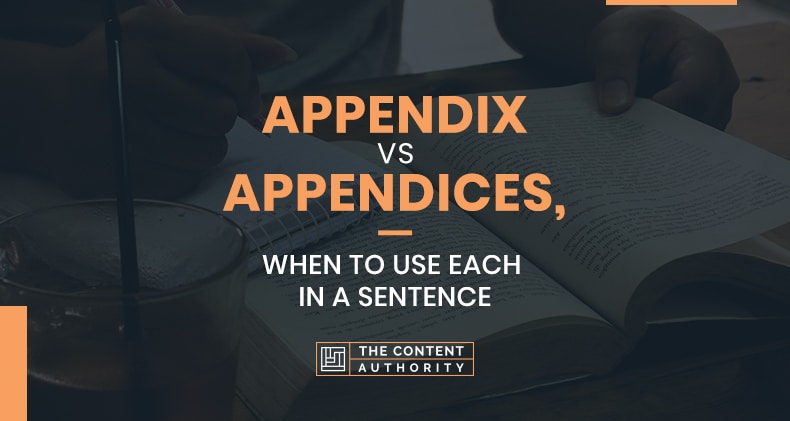There comes a moment when we have to face a dilemma while writing some specific words. We think we know how to use them, but in reality, we are not so sure.
They are both nouns that describe something different. An appendix is a text attached to an article or book that includes further information as well as a human body part. “Appendices” are the plural tense.
Origin Of Both Words
The word “appendix” comes from the Latin word “appendere,” which means “hang upon.”
There is a part of the human body that has the name we are talking about. But that word means something else in an entirely different context. Let me tell you a little more about both definitions so you can be clear.
The plural endings of foreign-derived words, like “appendix,” tend to become Anglicized. Across time. Multiple dictionaries now list words in their natural root state. Words like “gymnasiums”/”gymnasia,” “memorandums“/”memoranda,” and cactuses”/”cacti,” and more further.
More than a hundred years ago, the dictionary would have recommended, for the plural of the word “appendix,” “appendices” (in both senses). These days “appendixes” are preferred for both. Several dictionaries give the two options.
The word “appendix” is a homograph. That means it is spelled the same, but the meaning is different.
Do not mistake “Homographs” with “homophones” or “homonyms.”
Homophones are different in spelling or meaning but sound the same, and “homonyms” can be either or both.

Definition 1: Human Body Part
It is a thin, finger-shaped tube that extends out from the colon and rests where the small intestine meets the large intestine.
The appendix used to be viewed as a vestigial organ (organs that have lost their original function through evolution). This theory has changed over the past years. In modern humans, the appendix is a vestige of an organ that in old species had digestive duties. But recent studies imply that the appendix may serve an important mission. Notably, it may serve as a repository for helpful gut bacteria and may safeguard against the loss of symbiotic bacteria supporting digestion.
Scientists assume that the appendix can protect healthy bacteria located in the gut. And, when the gut is affected by an illness that cleans out the intestines, the beneficial bacteria in the appendix can repopulate the digestive system and keep us well.
One of the first investigators to work on the appendix’s function was Charles Darwin, which in his time had been recognized only in humans and other apes. He said that the far ancestors of these animals lived on a diet of leaves. So they required a large pouch, a portion of the gut that holds bacteria that can break down complex plant tissue. Later, he considered, these ancestors shifted to a more significant fruit-based diet that was simpler to digest. A large cecum or pouch was unnecessary, and it started to shrink; today, our cecum is tiny. So, he thought it carried no function.
Appendix disorders
- Appendicitis: It occurs when your appendix gets inflamed. Males have in their lifetime an 8.6 percent risk of appendicitis, according to the World Journal of Gastroenterology.
Females have in their lifetime a 6.7 percent risk of appendicitis.
To handle appendicitis, specialists would conduct an appendectomy to remove it. For unknown reasons, the appendix frequently becomes infected, inflamed, and can rupture. This causes hard pain in the right lower part of the belly, along with vomiting and nausea.
Numerous appendectomies are practiced to prevent disease rather than treat it. The rate of appendectomies is higher.
Appendicitis can pose dangers to your health, but surgery too. Some people question if preventive surgery is the best way.
- Tumors of the appendix: Cancer tumors secrete chemicals that generate frequent diarrhea, flushing, and wheezing. Tumors are lumps in the appendix that can be benign or cancerous. Appendix tumors are not common.
Definition 2: Part Of An Article Or A Book

An appendix includes material that is not a fundamental part of the text. Still, it may be useful in giving a complete understanding of the topic, or it is information that is too large to be incorporated into the body of the writing. A different appendix should be used for each different topic and always have a descriptive title of its contents.
An Appendix may cover some of the following:
- Specialized data
- Sample calculations
- Evidence.
- Technical figures, graphs, statistics
- A detailed description of research instruments
- Letters, emails, and other copies of correspondence
- Survey instruments/Questionnaire, with the results appearing in the text.
- Tables, Maps, charts, drawings, photographs
- Complete transcripts of interviews
- Specification or data sheets
- Full-field notes from observations
If you consider including content in an appendix, keep this in mind:
- Normally, it is best practice to include raw data.
- Tables and figures included should be numbered as a separate continuity from the main writing.
- If you have more than three, list them on a separate page at the start of your paper.
- The appendix can be a good spot to put non-textual elements, maps, diagrams, and photographs.
- An appendix should not be loaded with a lot of information.
How to format appendices
- If you add a Table of contents, then you must include the appendix
- Appendices may follow or precede your references list.
- Each appendix begins on a new page.
- “Appendix” should be the heading, followed by a number or letter [“Appendix A” or “Appendix 1”], centered and in bold.
- The content must have the order of a research paper.
- The page number(s) must continue with the numbering from the last page of the text.
It’s important to include appendices for these reasons:
- Data is too detailed to be easily compiled in the body of the article;
- Including this material in the body of the article would interrupt the narrative flow.
- The audience may get distracted from the main content of the paper as a result of the inclusion of helpful, supporting, or valuable material.
- If you have a limit regarding the length of the article.
- Provide information that is easily understood in a contained section.
- Provides a place to demonstrate your point of view of the problem by giving additional details about a new method, specialized information, or design protocols.
How People Use The Phrase

There are not many situations where you can use the word Appendix and its plural form “Appendices.” When you refer to that part of the body, which is one, and when you are talking about that extra part of an article or a book, you include information that complements all you have written, like an evidence section.
In both cases, you can use them in the plural.
Examples Of The Phrase In A Sentence
Here are some examples sentences using both words:
- Depending on the version, it is just under 3000 pages, not including appendices.
- Depending on the version, it is just under 150 pages, not including the appendix.
- The author includes four letters in the appendices that will soften your heart.
- The author includes one letter in the appendix that will soften your heart.
- He published three appendices, all considerably longer than the original article.
- He published all the raw information in the appendix.
- It has two appendices, with the source of information and public numbers.
- It has an appendix, with all the formulas and excel sheets.
- His appendix won’t resist much longer. He needs surgery now.
- The amount of appendices removed in this hospital has broken records in the past year.
- Darwin thought appendices were useless. But, if he were alive in this time, he may think otherwise.
- The appendix can cause a lot of trouble if it gets compromised.
Conclusion
We have covered all the possible uses of the word “appendix” and its plural form. All the examples provided cover both of the meanings of the word. One definition regards an internal part of the body. The other refers to a part of a book or an article used to include information to support the entire writing. There is no possible confusion here, but if somehow you find yourself with doubt, think that one is the plural of the other. If you are referring to something singular, then use “appendix.” That means one. If you use “appendices,” that means two or more.
Shawn Manaher is the founder and CEO of The Content Authority. He’s one part content manager, one part writing ninja organizer, and two parts leader of top content creators. You don’t even want to know what he calls pancakes.

